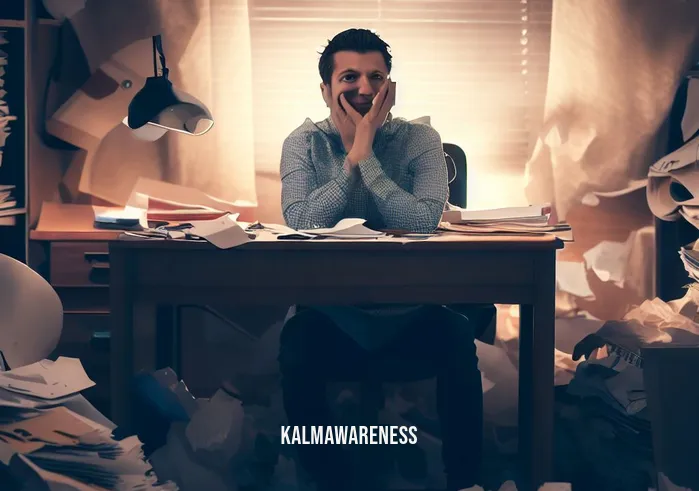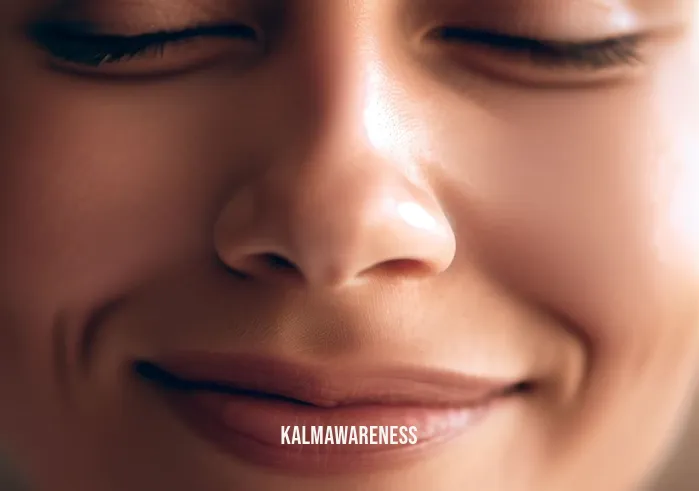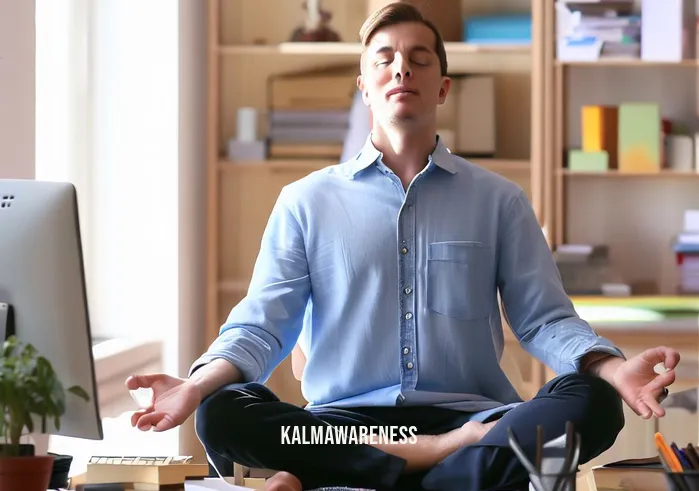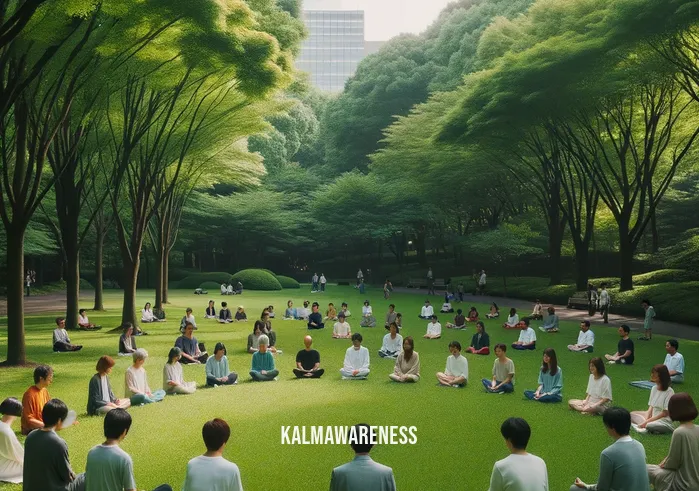Discovering Mindful Meditation Images: An Insightful Journey
The world we inhabit is bustling, dynamic, and at times, overwhelming. In such a setting, the importance of mental health and relaxation cannot be stressed enough. Enter the realm of mindful meditation images. These are not just photographs; they’re the bridges to a deeper understanding of mindfulness, visualization, and relaxation. They connect the nuances of photography with the essence of mental wellness. Throughout this series, we’ll traverse various facets of this topic, ranging from the historical practices of meditation to its present-day significance. And for those who have always thought of meditation solely as a still, quiet practice, prepare to be amazed.
Understanding Mindfulness and Meditation
At its core, mindfulness is about being present. It’s about living in the now, immersing yourself in the current moment without the constant pull of the past or the lure of the future. It’s the art of observing without judgment. When combined with meditation, it becomes a potent tool against stress, anxiety, and the myriad pressures of modern life.
Mindful meditation, particularly when complemented by visualization, offers a unique perspective. Instead of closing our eyes to imagine a scenario, we can use mindful meditation images as a focal point, aiding our concentration and deepening our meditation experience. These images become a nexus between the seen and the unseen, the explicit and the implicit.
A Journey Through Photography
Photography is an art form that captures moments, emotions, and narratives in a frame. It’s not merely about what is seen but also about what is felt. Meditation in motion elucidates this concept beautifully. While a photo can be a static representation, the stories it holds within can be dynamic and ever-evolving.
Similarly, the practice of micromeditating allows us to find moments of mindfulness amidst the chaos of daily life. Just as a photo can transport us to a different place or time, a few minutes of focused meditation can offer a refreshing pause in our hectic schedules.
The Rich History Behind Meditation
Meditation is not a new-age concept. It has roots stretching far and wide across cultures and ages. For instance, the ancient African meditation techniques provide a testament to the timeless nature of this practice. Over time, various cultures have added their interpretations and methodologies, enriching the practice further.
The Penn mindfulness class is one such modern interpretation, blending age-old techniques with contemporary needs. Similarly, the integration of mindfulness in areas like mindful martial arts showcases the versatility of the practice.
Bridging the Gap with Mindful Meditation Images
For many, especially the visual learners among us, images offer a way to understand and relate to concepts better. They offer a tangible element to an otherwise intangible practice. These images could range from serene landscapes that invoke calmness to intricate patterns that help focus the wandering mind.
The beauty of these images is in their ability to resonate with our inner selves. They act as mirrors, reflecting our internal state and helping us navigate our meditation journey. In this essence, a mindful muscle isn’t just about physical strength but also about the strength of presence, understanding, and introspection.
What Awaits in the Upcoming Discussions
While we’ve provided an overarching view of mindful meditation images in this segment, the depth and expanse of this topic are vast. In the next segment, we’ll delve deeper into how visualization plays a pivotal role in enhancing meditation experiences. We’ll also touch upon how modern practices like gratitude yoga integrate imagery to heighten awareness and presence.
As we continue this enlightening journey, anticipate a blend of historical wisdom, contemporary practices, and the transformative power of images. So, if you’re ready to immerse yourself further and understand the profound impact of mindful meditation images on mental health, relaxation, and overall well-being, do proceed to our next segment. It promises to be an enlightening continuation of this exploration.

The Power and Significance of Mindful Meditation Images
Visual aids have always been a cornerstone in the process of understanding and learning. When it comes to the realm of mindfulness and meditation, images serve as more than mere illustrations; they become gateways to deeper comprehension and immersive experiences. In this segment, we’ll further explore the pivotal role of mindful meditation images in the holistic meditation journey.
Visual Aids: A Catalyst for Deeper Understanding
Our brain processes visuals 60,000 times faster than text. When we integrate these visuals into the meditation process, we cater to this intrinsic human preference, enhancing the efficacy of the practice. Not only do these images serve as a focal point during meditation, but they also:
- Act as reminders to return to the present moment, as emphasized in mindfulness books for teens.
- Help in setting the ambiance for a calming session, akin to the experiences shared in meditation stories for students.
- Offer a tangible representation of abstract concepts, making it easier to grasp and implement teachings, similar to how mindful skills are illustrated.
Benefits of Incorporating Images in Meditation Practices
- Visualization: Pictures provide clarity, enabling better visualization, which is central to many meditation techniques.
- Focus: For those finding it challenging to concentrate, a mindful meditation image can serve as an anchor.
- Cultural Integration: Images from different cultures, like the ancient African meditation techniques, can help broaden horizons and add depth to one’s practice.
- Emotional Elicitation: Certain images can evoke specific emotions, aiding in meditation practices that aim to cultivate or release particular feelings.
Breakdown of Mindful Meditation Images
To offer a clearer perspective, let’s categorize various mindful meditation images:
| Type of Image | Purpose | Example |
|---|---|---|
| Nature landscapes | Instilling calm and serenity | Pictures of serene lakes or tranquil forests |
| Geometric patterns | Enhancing focus and concentration | Mandalas or intricate designs |
| Cultural depictions | Broadening understanding and inclusivity | Images from mindful en español or other cultural sources |
| Abstract illustrations | Aiding in visualization and creativity | Cloud formations, color swirls |
| Motivational images | Encouraging persistence and dedication | Quotes overlaid on calming backgrounds |
Choosing the Right Image for Your Meditation Session
Not every image will resonate with every individual. It’s essential to:
- Understand the goal of your meditation session: Is it relaxation, focus, or maybe gratitude as practiced in gratitude yoga princeton?
- Match the image to the emotion or state you wish to evoke.
- Ensure the image is clear, high-quality, and free of distractions.
- Experiment with different images over time to find what works best for you.
Looking Ahead
Images, with their profound impact, have seamlessly woven their way into the fabric of meditation practices. As we further embrace the digital age, the fusion of these visual aids with traditional meditation techniques promises a richer, more enhanced experience.
But the journey doesn’t end here. In the next chapter, we’ll dive into the science behind why these images work so effectively. We’ll explore the neurology of meditation, the psychology of visuals, and how the two beautifully converge to elevate our mindfulness journey. For those curious about the ‘why’ behind the ‘what,’ the next segment promises a deep dive into the science of mindful meditation images.

Harnessing the Inspirational Power of Mindful Meditation Images
In every individual’s journey toward self-awareness and inner peace, there are moments when the path seems clouded by uncertainties and challenges. However, the right inspiration can illuminate even the murkiest of pathways. Within the realm of mindfulness and meditation, mindful meditation images have emerged as profound sources of hope and motivation. As they say, an image is worth a thousand words, and in our context, possibly a thousand inspirations.
The Spark in Visual Representations
Every image has a story, an emotion, a message. Mindful meditation images are no exception. They encapsulate vast landscapes of emotions, lessons, and inspirations in the confines of their frames. For instance, consider a solitary tree in a vast desert showcased in a renewed mind employee portal. Such an image doesn’t just represent resilience and perseverance but also highlights the power of standing tall amidst adversities.
“The mind can go in a thousand directions, but on this beautiful path, I walk in peace. With each step, the wind blows. With each step, a flower blooms.” – Thich Nhat Hanh
The quote, when juxtaposed with the image, adds layers of understanding, guiding meditation practitioners to find peace even when their surroundings seem contrary.
Stories of Transformation
One of the most compelling testimonials of the impact of mindful meditation images comes from practitioners who’ve integrated these into their routines.
Mara’s Journey: Mara, a dedicated follower of mindful hiking, struggled with finding consistency in her meditation practice. It was only when she started using images of mountain trails and serene forests that she could truly connect with her inner self. The images were not just reminders of her hikes but also symbolized the journey within.
“In the midst of movement and chaos, keep stillness inside of you.” – Deepak Chopra
Mara’s experience is a testament to the tranquility and stillness that mindful meditation images can introduce amidst the chaos of daily life.
Jacob’s Transformation: Jacob, influenced by meditation consultant practices, was always intrigued by the power of visualization in healing. After a personal loss, he found solace in images of sunrise. For him, these images symbolized hope, a new beginning after a dark night.
“Every sunset is an opportunity to reset. Every sunrise begins with new eyes.” – Richie Norton
Embracing the Motivation
It’s no secret that visual inspirations can play a massive role in personal growth. Whether it’s through:
- Guided Visualization: Techniques from the meditation for menopause community often involve visualizing serene scenarios, offering both solace and rejuvenation.
- Setting Ambiance: As depicted in mindful miracle, the right images can set the mood for a transformative meditation session.
- Stoking Internal Flames: Mindful meditation images can act as fuel for the innate motivation and hope that reside within us.
“Hope is like the sun, which, as we journey toward it, casts the shadow of our burden behind us.” – Samuel Smiles
Gearing Up for a Deeper Dive
While we’ve touched upon the inspirational facets of mindful meditation images, it’s only the tip of the iceberg. These images offer a treasure trove of insights, learnings, and transformations waiting to be uncovered.
In our next chapter, we’ll delve deeper into the artistry behind creating these images. From choosing the right color palettes to understanding the impact of different visual elements, get ready for a fascinating exploration into the world of creating inspirational mindful meditation images.

Crafting the Perfect Mindful Meditation Image: An Art and Science
To the untrained eye, mindful meditation images might seem like simple, soothing pictures. However, there’s a deep science and a meticulous art behind crafting the perfect image that not only appeals to our visual senses but also aids in deepening our meditative experiences. This chapter ventures behind the lens, breaking down the elements that make these images both aesthetically pleasing and functionally effective.
The Essential Elements of a Mindful Meditation Image
Composition: Just as in any form of photography, the way elements are arranged within the frame can determine the emotional and cognitive impact of the image.
- Rule of Thirds: A principle where the image is divided into nine equal segments by two vertical and two horizontal lines. The idea is to position the important elements of your scene along these lines, or at the intersections of them.
- Leading Lines: These guide the viewer’s eye towards the main subject or a journey through the entire image.
- Symmetry and Patterns: Found in nature and human-made structures, they offer a sense of harmony and balance.
Color Palette: Different colors evoke varied emotions. While blues and greens might induce feelings of calmness and serenity, vibrant colors like red and orange might energize the viewer. As portrayed in the mindful martial arts community, using appropriate colors can significantly enhance focus and discipline.
Subject Matter: This is crucial, especially when tailoring an image to a specific meditation goal.
- Nature: Ideal for inducing feelings of calm, peace, and interconnectedness.
- Abstract Patterns: Best suited for meditations that aim to enhance focus or spark creativity.
- Cultural and Historical Elements: Offer depth and context, much like the insights from ancient African meditation techniques.
Texture and Depth: These add a tactile dimension to the image.
- Smooth Textures: Think water bodies or clear skies, they often induce a sense of peace and tranquility.
- Rough Textures: Such as rugged mountains or dense forests, can be grounding, enhancing feelings of resilience and strength.
Clarity and Focus: A well-defined subject against a soft, blurry background (known as bokeh) can help in drawing attention and aiding concentration. This principle is well-demonstrated in meditation pleine conscience practices.
Choosing the Right Image
Once you’re familiar with the elements, the next step is selecting or creating the right image tailored to your meditative goals:
- Determine the Purpose: Is the meditation aimed at relaxation, gratitude, focus, or healing? This will guide your image choice.
- Cultural Relevance: For some, images from their cultural background, like those highlighted in mindful en español, can enhance the sense of connection and belonging.
- Personal Resonance: The most effective images are often those that resonate on a personal level. An image that evokes a cherished memory or aligns with personal beliefs can be profoundly impactful.
Concluding Thoughts and What Lies Ahead
Images are more than just visual stimuli. In the realm of mindful meditation, they are catalysts, guides, and companions. Crafting or choosing the right image, thus, becomes a journey in itself, leading to deeper, more enriching meditation experiences.
As we gear up for our final chapter, we’ll explore the transformative impacts of incorporating these images into daily meditation routines. From real-life testimonies to scientific findings, prepare to be amazed by the profound influence of mindful meditation images on the human psyche.

Reflecting on the Journey: The Magic of Mindful Meditation Images
As we find ourselves at the end of this enlightening exploration, it’s time to pause, breathe, and reflect on the myriad ways mindful meditation images have illuminated our understanding of mindfulness and meditation. Through the chapters, we’ve traveled through time, culture, science, and art, all the while guided by these captivating images that are worth much more than a thousand words.
A Glimpse of the Expedition
Understanding Mindfulness: We embarked by grasping the essence of being present, and how life is available only in the present moment.
Visual Catalysts: Our journey deepened as we discovered the potency of images in reinforcing our meditation practices. Their ability to evoke emotions, guide visualizations, and offer solace became apparent.
Inspiration and Hope: We felt the warmth of inspiration, understanding how these images can instill hope, perseverance, and a renewed sense of purpose.
The Science and Art: The meticulous crafting behind every image was unraveled, appreciating the harmonious blend of science and artistry.
Putting Knowledge into Practice
With all this newfound knowledge, how can we integrate it into our daily lives? Here are a few starting points:
Personalized Meditation Sessions: Curate a collection of images that resonate with you. Use them as focal points in your daily meditation routines.
Explore Further: Dive into resources like mindful hiking to integrate mindfulness into different aspects of your life.
Share the Joy: Introduce friends and family to the concept. Maybe even conduct a group meditation session using a universally appealing image as a focal point.
A Call to Action
For those who’ve found this journey enriching, the exploration doesn’t end here. We urge you to delve deeper into the treasure trove of content available in our magazine. Whether you’re curious about the nuances of mindful martial arts or want to revisit our insights on micromeditating, there’s a wealth of knowledge waiting to be unearthed.
A Heartfelt Thank You
To our esteemed readers, thank you for being a part of this enlightening voyage. Your curiosity and eagerness to learn have made this exploration worthwhile. We hope you carry forward the essence of what you’ve gleaned, integrating the magic of mindful meditation images into your lives.
Rest assured, we’ll be back with more insights, stories, and knowledge in our future editions. Until then, keep exploring, keep learning, and remember, every image holds a universe of possibilities.
Stay mindful!





